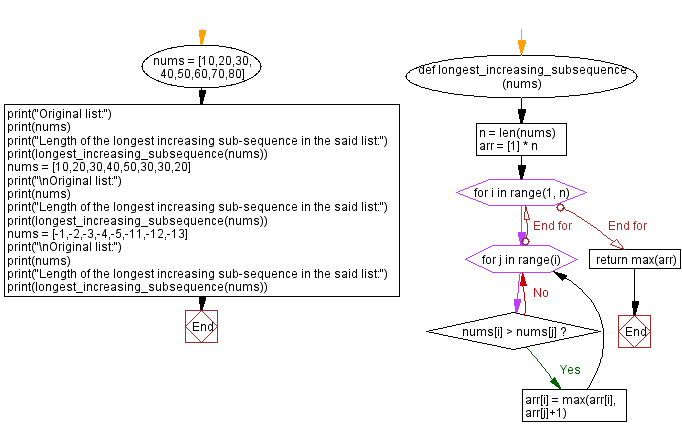Python List Advanced Exercise - Length of the longest increasing sub-sequence
2. Length of Longest Increasing Subsequence
Write a Python function find the length of the longest increasing sub-sequence in a list.
Sample Solution:
Python Code:
# Define a function to find the length of the longest increasing subsequence in a list
def longest_increasing_subsequence(nums):
# Get the length of the input list
n = len(nums)
# Create a list 'arr' to store the length of the longest increasing subsequence
arr = [1] * n
# Iterate over the elements in the list
for i in range(1, n):
# Iterate over elements before the current element 'i'
for j in range(i):
# Check if the current element is greater than the previous element
if nums[i] > nums[j]:
# Update the length of the longest increasing subsequence for the current element 'i'
arr[i] = max(arr[i], arr[j] + 1)
# Return the maximum value in the 'arr' list, which represents the length of the longest increasing subsequence
return max(arr)
# Create a list of numbers
nums = [10, 20, 30, 40, 50, 60, 70, 80]
# Print the original list
print("Original list:")
print(nums)
# Call the longest_increasing_subsequence function and print the result
print("Length of the longest increasing sub-sequence in the said list:")
print(longest_increasing_subsequence(nums))
# Create another list of numbers
nums = [10, 20, 30, 40, 50, 30, 30, 20]
# Print the original list
print("\nOriginal list:")
print(nums)
# Call the longest_increasing_subsequence function with the second list and print the result
print("Length of the longest increasing sub-sequence in the said list:")
print(longest_increasing_subsequence(nums))
# Create a third list of negative numbers
nums = [-1, -2, -3, -4, -5, -11, -12, -13]
# Print the original list
print("\nOriginal list:")
print(nums)
# Call the longest_increasing_subsequence function with the third list and print the result
print("Length of the longest increasing sub-sequence in the said list:")
print(longest_increasing_subsequence(nums))
Sample Output:
Original list: [10, 20, 30, 40, 50, 60, 70, 80] Length of the longest increasing sub-sequence in the said list: 8 Original list: [10, 20, 30, 40, 50, 30, 30, 20] Length of the longest increasing sub-sequence in the said list: 5 Original list: [-1, -2, -3, -4, -5, -11, -12, -13] Length of the longest increasing sub-sequence in the said list: 1
Flowchart:

What is the time complexity and space complexity of the following Python code?
def longest_increasing_subsequence(nums):
n = len(nums)
arr = [1] * n
for i in range(1, n):
for j in range(i):
if nums[i] > nums[j]:
arr[i] = max(arr[i], arr[j]+1)
return max(arr)
Time complexity - The time complexity of the given code is O(n^2), where n is the length of the input array “nums”. This is because there are two nested loops, each ranging from 0 to n-1. Therefore, the total number of iterations is n*(n-1)/2, which is O(n^2) in the worst case.
Space complexity - This code has a space complexity of O(n), since it uses an additional array "arr" to store the lengths of the increasing subsequences ending at each index of "nums".
For more Practice: Solve these Related Problems:
- Write a Python function using dynamic programming to compute the length of the longest increasing subsequence in a list.
- Write a Python function to return both the length and the elements of the longest increasing subsequence using memoization.
- Write a Python function to find the length of the longest contiguous increasing sub-sequence in a list.
- Write a Python function that employs recursion to compute the longest increasing subsequence length and compare it with an iterative solution.
Go to:
Previous: Reverse a list at a specific location.
Next: Permutations of the members of a list.
Python Code Editor:
What is the difficulty level of this exercise?
Test your Programming skills with w3resource's quiz.
